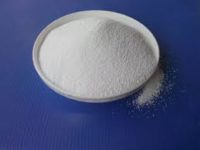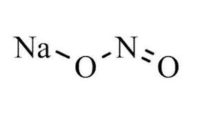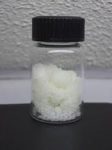- Health and Disease Applications :Sodium nitrite may have several applications in the fight against disease and organ damage. Sodium nitrite may be used to improve blood circulation, particularly to parts of the body that are injured or damaged. Low concentrations of sodium nitrite can be used to treat diseases. Sodium nitrite in combination with sodium nitrate can heal cardiovascular conditions by strengthening or repairing damaged blood vessels. It is a vasodilator, intestinal relaxant, bronchodilator, and an antidote to cyanide poisoning, and hydrogen sulfide poisoning.
- Dye Creation:Sodium nitrite is often used to form dyes for the coloring of linens. The dye-creation process can be dangerous when chemicals such as sodium nitrite are used.
- Curing Meat:In most cases, meats are cured using sodium nitrite. Although some meats require sodium nitrate a close relative of sodium nitrite for proper curing, these are often meats requiring a longer aging process. Curing meat with this chemical helps preserve the meat and delay the onset of botulism, a deadly disease that can be borne in spoiled foods. Curing also infuses the meat with a distinct flavor and causes the meat to develop a bright pink hue when cooked.
- Botanical Uses :Sodium nitrite is common in fertilizer, as well as in some herbicides and insecticides. It’s used because it can help kill off living organisms that pose a threat to plant life without harming the flora itself.
- Food Preservative :Sodium nitrite is commonly used in the food industry as a stabilizer and an additive. It has antimicrobial properties that inhibit the growth of harmful pathogens and disease-causing bacteria. Sodium nitrite is used to preserve fish and meats, such as hot dogs, smoked fish and luncheon meats. It prevents meat from developing botulism, which is a serious disease caused by the bacterium Clostridium botulinum in food. The Food and Drug Agency limits the use of sodium nitrite to 200 parts per million in food products in the United States.
- Pigments and Dyes:Sodium nitrite is used as a bleaching and dyeing agent. It is used to make basic dye, acid dye, and direct dye, and sulfur dye, diazo and azoic dyes. Sodium nitrite dye irritates the respiratory system, eyes and skin, and should be handled with care. Its ingestion is toxic, and sodium nitrite can prove to be an explosion hazard if heated with a flammable material.
- Other Uses:Other uses of sodium nitrite include the manufacture of herbicides, organic insecticides, decaling of cast iron and steel, as an inhibitor of polymer, anti-freeze liquids, lubricants, rubber-processing, pulp-and-paper industries, industrial and household cleaners, and as a raw material in the production of products such as caffeine and saccharine.
Sodium Nitrite is an inorganic compound with chemical formula NaNO2 and as the sodium salt of nitrous acid HNO2. It forms white to slight yellowish crystalline powder in pure state. Sodium nitrate is hygroscopic and very soluble in water. It can be found in nature in several vegetables, such as spinach, parsley, lettuce, broccoli, curly kale, and asparagus. It also can be found in human body to control bacteria in the stomach and prevent gastroenteritis.
Sodium nitrite can be manufactured by reacting sodium hydroxide with nitrogen monoxide and nitrogen dioxide. The product from this process is sodium nitrite that diluted in water. To obtain crystalline sodium nitrite, it the solution undergoes to next stage which is evaporation. Sodium nitrite can be decomposed to sodium dioxide, nitrogen dioxide, and oxygen when it heated at high temperature. Also in laboratory scale, sodium nitrite can be used to destroy excess sodium azide.
- Sodium Nitrite Injection: Sodium nitrite injection is indicated for sequential use with sodium thiosulfate for the treatment of acute cyanide poisoning that is judged to be life-threatening. When the diagnosis of cyanide poisoning is uncertain, the potentially life-threatening risk associated with Sodium Nitrite is injected. Sodium nitrite is an antidote for cyanide poisoning. Cyanide poisoning can be rapidly fatal. When hydrogen cyanide gas or large doses are taken, toxicity occurs within a few seconds, and death occurs within minutes. With smaller doses, toxicity occurs within minutes. Sodium nitrite is generally used in conjunction with sodium thiosulfate, and often amyl nitrite, in the treatment of cyanide poisoning. Cyanide has a high affinity for ferric ions, and reacts readily with the ferric ion of mitochondrial cytochrome oxidase. Sodium nitrite reacts with haemoglobin to form methaemoglobin, and cyanide preferentially binds to methaemoglobin, restoring cytochrome oxidase activity. As cyanide dissociates from methaemoglobin, it is converted to the relatively non-toxic.
- Safety : While this chemical will prevent the growth of bacteria, it can be toxic in high amounts for animals, including humans. Sodium nitrite is an irritant to the eyes, lungs and skin, is toxic when consumed and has the potential to explode when heated. If sodium nitrite is defanged by preventing it from becoming a nitrosoamine, the risks associated with it are minimal. Although it is toxic, the FDA has classified it as generally recognized as safe. The fatal dose of this chemical is between 22 to 23 mg per kilogram of body weigh
| PRODUCT IDENTIFICATION | |
|---|---|
| CAS No | 7632-00-0 |
| FORMULA | NaNO2COOH |
| Molar mass | 68.9953 g/mol |
| Appearance | white or slightly yellowish solid |
| Density | 2.168 g/cm3 |
| Melting point | 271 °C, 544 K, 520 °F (decomp.) |
| Solubility in water | 84.8 g/100 mL (25 °C) |
| Solubility in methanol | 4.4 g/100 mL |
| Slightly soluble in diethyl ether | 0.3 g/100 mL |
| Solubility in ammonia | Highly soluble |
| Refractive index (nD) | 1.65 |





